You maintain plenty of routines when it comes to your dog’s health. You go for daily walks, you brush their coats, you feed a high-quality diet, and you provide plenty of water at all times. Now that you know how you even attend to their ears. But what about their teeth? Do you brush your dog’s teeth regularly? Irregularly? At all? If you aren’t attending to your dog’s dental health, it’s time to invest in a quality dog toothpaste and shine up those pearly whites.
Periodontal Disease in Dogs
You brush your teeth every day. Why? You know the importance of tooth and gum health. Dogs need the same care. Periodontal disease is the MOST common finding in adult dogs. Periodontal disease is an affliction of the teeth and gums, resulting from plaque (food particles and bacteria accumulation along the gum line) and gingivitis (inflammation of the gums).
Why is periodontal disease such a big deal? It attacks your dog’s mouth, resulting in painful oral abscesses and tooth decay. Your dog finds it difficult to eat. Even worse, the bacteria enter your dog’s bloodstream, finding their way to your dog’s critical organs. A compromised mouth has the potential to bring down other parts of your dog’s body. (NOT what you want to happen!)
If you have certain breeds, such as a Pug, your dog has an inherent risk for periodontal disease. Brachycephalic breeds, in general, tend toward poor dental health. Other breeds at risk for frequent dental visits include:
- Chihuahuas
- Collies
- Dachshunds
- Greyhounds
- Poodles
- Yorkshire Terriers
All of this gets resolved with a straightforward step: brushing your dog’s teeth.

Brushing Your Dog’s Teeth
Just as with ear-cleaning, brushing your dog’s teeth takes practice and patience. The earlier you start the process – either with your puppy or new rescue – the better your results. ALWAYS use a dog toothbrush (sized for your dog’s mouth) and dog toothpaste.
- Place a tiny amount of toothpaste on the toothbrush for your dog to lick. If your dog gets a chance to taste the toothpaste, brushing gets easier. Go no further for about a week.
- Now that your dog’s comfortable with the dog toothpaste, move on to brushing their teeth. Gently raise the lips to expose the teeth and gums. DON’T force their mouth open.
- Start brushing, starting with the front teeth. Monitor your dog to make sure they’re comfortable. If they start to panic or get upset, abandon ship for another day.
- Move to the back teeth. Your dog should open their mouth on their own – NO FORCING. You want to get the inside and outside of the teeth.
- Give them a treat when finished.
Why Dog Toothbrush and Toothpaste?
Human toothbrushes get designed with our mouths in mind. They’re larger, the bristles are stiffer (even soft brushes), and the angles suit our jaws. Dog toothbrushes come in two general varieties: a standard-looking brush and a finger brush. They’re a smaller scale, the bristles are gentler, and the angle fits your dog’s mouth. Finger brushes are fine for medium or large dogs, but they’re oversized for small dogs unless you have tiny fingers. Your dog will let you know what suits them.
Dogs don’t rinse and spit. They swallow the toothpaste you use. As such, the ingredients need to be safe on their stomachs. Human toothpaste tends to contain chemicals that irritate a dog’s stomach lining – in a best-case scenario. Worst-case scenario, human toothpaste contains xylitol. This artificial sweetener is toxic to dogs. That fluoride we rely on? It’s another toxin for dogs. As such, stick to dog toothpaste.
Choosing a Dog Toothpaste
You know which ingredients to avoid (all human toothpaste is off the list). But which dog toothpastes are the best? There are a lot of them out there. According to Dr. Colleen Fox, DVM, at the Center of Veterinary Expertise (the amazing veterinarian who’s cared for my pets’ teeth), you want to check the label for the Veterinary Oral Health Council (VOHC) seal of approval. That seal indicates the dog toothpaste (or other product) retards plaque and tartar on teeth.
What else should you look for in a dog toothpaste?
- Silica: Silica is a gentle abrasive. It removes tartar and plaque from your dog’s teeth.
- Emulsifiers: Tetrapotassium phosphate is one such salt. Emulsifiers control tartar build-up. Don’t let the long words scare you – you find these emulsifiers in everyday dairy products, such as cheese and ice cream.
- Sweetener: Sorbitol is a common dog-safe sugar alcohol used in dog toothpastes. Sweeteners make the toothpaste more appealing. While you find many available flavors of toothpaste, you’ll still see sweeteners in the ingredients.
Enzymatic Dog Toothpastes
You may or may not see proteins known as enzymes in the ingredient list. Enzymatic toothpastes have antibacterial formulas that break down plaque and tartar. They reduce the number of bacteria present, which also helps in the halitosis (bad breath) department. If you’re interested in an enzymatic dog toothpaste, look for ingredients such as:
- Lactoperoxidase
- Glucose oxidase
Best Dog Toothpastes
Hit the internet or the aisles of your local pet store, and you’ll find a cornucopia of dog toothpaste. Before you load up your cart, visit your veterinarian. A professional cleaning provides you with a blank canvas. Also, you’ll root out any potential problems you might miss. (Dogs are surprisingly stoic when it comes to tooth issues) Once your dog’s teeth are squeaky clean, these are the best dog toothpastes available.
Best Enzymatic Dog Toothpastes
The bacteria that inhabit your dog’s mouth pose a risk to your dog’s entire system. Severe periodontal disease can affect your dog’s liver, kidney, and heart. If your trip to the vet revealed significant tartar build-up and gingivitis, consider an enzymatic dog toothpaste.
Everyone’s familiar with Arm & Hammer’s baking soda power. This dog toothpaste employs baking soda to scrub your dog’s tooth staining. The gentle enzymatic formula banishes harmful bacteria, helping prevent expensive veterinary cleanings. The chicken flavor is appealing to your dog, making teeth brushing easier on you.
Downsides? There is no sweetener in this dog toothpaste, so not all dogs appreciated the taste (chicken flavoring or not). Also, owners didn’t enjoy the smell (but if it keeps your dog’s teeth clean and healthy, you might consider putting up with it).
The Good
- Baking soda formula
- Cleanses away bacteria
- Dog-approved chicken flavor
The Bad
- No sweetener
- Owners don't like the smell
Are you looking for a budget-friendly enzymatic option? Try Nutri-Vet. Their chicken-flavored toothpaste is a non-foaming enzymatic formula. In fact, their formula is very similar to Sentry’s, minus the hydrogen peroxide, which can upset your dog’s stomach. If you want to protect your dog’s GI system while also preserving their dental health, Nutri-Vet is a great compromise.
The downside? Unhappily, not all dogs approve of the flavor.
The Good
- Non-foaming formula provides antibacterial protection, removes plaque, and prevents tartar
The Bad
- Not all dogs like the flavor
Are you looking for a complete dental kit? Paws & Pals has your solution. You not only get two tubes of their beef-flavored enzymatic dog toothpaste but a dual-headed soft-bristle toothbrush and a finger brush. The enzymatic formula protects your dog’s teeth from plaque and tartar build-up while freshening their breath.
So what’s the downside? While most dogs like the beef flavor, it isn’t a hit with everyone.
The Good
- Kit includes 2 tubes of toothpaste, soft bristle brush, and finger brush
- Formula protects against tartar build-up and scrubs away plaque
The Bad
- Not all dogs like the taste
Sentry provides another option for those looking for an entire dental kit. You get a tube of poultry-mint dog toothpaste, a 360-degree toothbrush of soft bristles, and a finger brush. Their enzymes neutralize odor-producing bacteria while breaking down and preventing plaque and tartar. The formula produces hydrogen peroxide, leaving your dog’s teeth sparkling white (with regular use). While other enzymatic dog toothpastes tend to foam, Sentry is non-foaming.
Downsides? Hydrogen peroxide might be great for stained teeth, but it upsets stomachs and can damage the lining over time. You need to ask yourself whether your dog’s GI health is worth the risk. Some owners found their dogs didn’t like the taste, and others found minimal difference in plaque build-up.
The Good
- Kit includes tube of toothpaste, soft bristle brush, and finger brush
- Neutralizes bacteria, breaks down plaque, and prevents tartar
The Bad
- Hyrdogen peroxide upsets the stomach and damages GI tract lining
- Not all dogs like the taste
Vet’s Best utilizes neem oil, grapefruit seed extract, aloe, and enzymes to keep your dog’s mouth healthy. Their combination formula is antibacterial AND antifungal, promising your dog’s breath will stay clean and pleasant. For those who aren’t fans of pastes, the gel makes a friendly alternative come brushing day.
The downsides? The gel formula is stickier than most dog toothpastes, so it tends to make a mess. This also made it difficult for people to get the gel out of the tube. Some owners also found their dogs weren’t fans of the taste.
The Good
- Natural ingredients
- Antibacterial and antifungal
- Gel instead of a paste
The Bad
- Sticky
- Not all dogs like the taste
Tired of limited flavors your dog hates? Virbac solves that problem with FIVE different flavors: poultry, malt, beef, seafood, and vanilla-mint. The dual-enzyme system is non-foaming and eliminates mouth odors while providing antibacterial protection, removing plaque, and preventing tartar build-up. Owners note whiter and cleaner teeth with happier dogs (and cats) during brushing time.
So what are the downsides? It’s on the expensive side, especially if you have a larger dog. Dogs don’t usually like the vanilla-mint flavor (cats don’t mind it). Also, the tube tends to break down quickly, so you need to use it consistently.
The Good
- 5 different flavors
- Non-foaming formula provides antibacterial protection, removes plaque, and prevents tartar
The Bad
- Expensive
- Tube can break down
Best Non-Enzymatic Dog Toothpastes
If you’re not in the market for an enzymatic dog toothpaste, you still have great options available. Maybe your dog received a gold star from the vet. Perhaps you have a new puppy, still cutting their baby teeth. Whatever the reason, non-enzymatic dog toothpastes are every bit as good for your dog’s dental health. The fact you’re brushing your dog’s teeth is what matters.
Are you worried about sorbitol and other sweeteners? EZ Dog has you covered. Their non-foaming dog toothpaste contains Stevia to sweeten their vanilla-flavoring. Manufactured in the United States, the ingredients are all-natural (Stevia comes from herbal preparations). Your dog’s breath stays fresh while their teeth get clean.
Downside? This dog toothpaste isn’t thick, so it runs down the brush instead of staying on the bristles. This caused a mess for a lot of owners.
The Good
- Non-foaming formula
- Stevia sweetener
The Bad
- Thin formula creates a mess
Nylabone’s dental kit gets you off on the right foot. You get a tube of their dog toothpaste, an angled toothbrush of soft bristles, and a finger brush. Their peanut butter-flavored toothpaste appeals to the majority of dogs, making brushing time easy. Their Denta-C formula reduces plaque and tartar.
The downsides? Not only does this dog toothpaste contain peanut butter, but it’s also made in a plant that processes peanuts. So if you, your dog, or anyone in the household has a peanut allergy, be prepared. Owners also didn’t feel it was as effective at removing plaque and tartar.
The Good
- Kit includes tube of toothpaste, angle toothbrush, and fingerbrush
- Denta-C formula reduces plaque and prevents tartar
The Bad
- Contains peanut butter
- Processed in plant that handles peanuts
- Not as effective as other dog toothpastes
Are you looking for that VOHC seal? PetSmile bears the seal proudly. This dog toothpaste contains Calprox, which safely prevents plaque, fights bacteria, and improves nasty breath. The tube comes with a finger brush, and it has a London broil flavor dogs enjoy. This dog toothpaste is meant for usage 2-3 times a week for the best results.
We use this dog toothpaste for our girl, and she receives glowing praise on her teeth every vet visit.
So what are the downsides? It’s expensive. Also, the toothpaste settles in the tube, so you need to shake it before each use (up to you whether you feel this is a deal-breaker). People think the looser gel doesn’t work with a toothbrush, but we’ve had no problems.
The Good
- VOHC seal
- Calprox removes plaque, fights bacteria, and improves bad breath
- Finger brush included
The Bad
- Expensive
- Need to shake tube before use
- Gel may slide off toothbrush
If you’re worried about ingredients, RADIUS provides USDA organic certification. Their dog toothpaste is free of chemicals, dyes, preservatives, and artificial additives. The formula still freshens your dog’s breath while fighting plaque and removing tartar. The kit provides a tube of toothpaste and an easy-to-hold toothbrush with soft bristles.
Downside? People were generally happy with RADIUS, but they felt the 4-ounce tube was too small.
The Good
- Kit includes toothpaste and toothbrush
- Organic ingredients
The Bad
- Tube is only 4 ounces
Are you concerned with your ability to brush your dog’s teeth? Tropiclean provides the answer. No need for a toothbrush; apply two drops of the gel to each side of your dog’s mouth. The formula of the toothpaste goes to work with your dog’s saliva. The natural ingredients include green tea, all sourced from the United States. You have the option of picking up a single 4-ounce tube or a two-pack, depending on your needs.
The downsides? Dogs weren’t fans of the taste. Also, owners reported their dogs ended up with upset stomachs.
The Good
- No need for brushing
- Natural ingredients
- Formula works with dog's saliva
The Bad
- Not all dogs like the flavor
- Dogs can get upset stomachs
Show That Smile
You don’t need to brush your dog’s teeth every day; 2-3 times a week is sufficient. However, if you DON’T brush daily, consider supplementing with dental treats and chews on your off days. You’ll keep your dog’s teeth and mouth healthy, protecting their internal organs from harmful bacteria.
Brushing your dog’s teeth takes patience and practice. Once you get the hang of things, you and your dog will come to look forward to the task. Your vet will appreciate your work, and your bank account will benefit from the absence of costly dental cleanings and extractions.
So pick out a dog toothbrush and toothpaste, and start practicing. You won’t regret it!



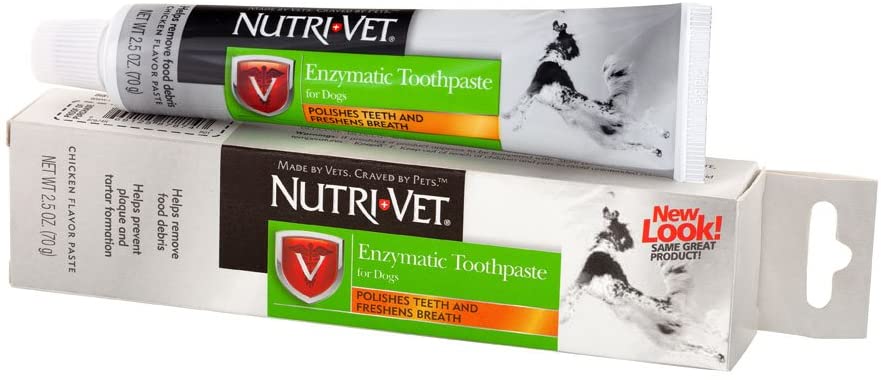
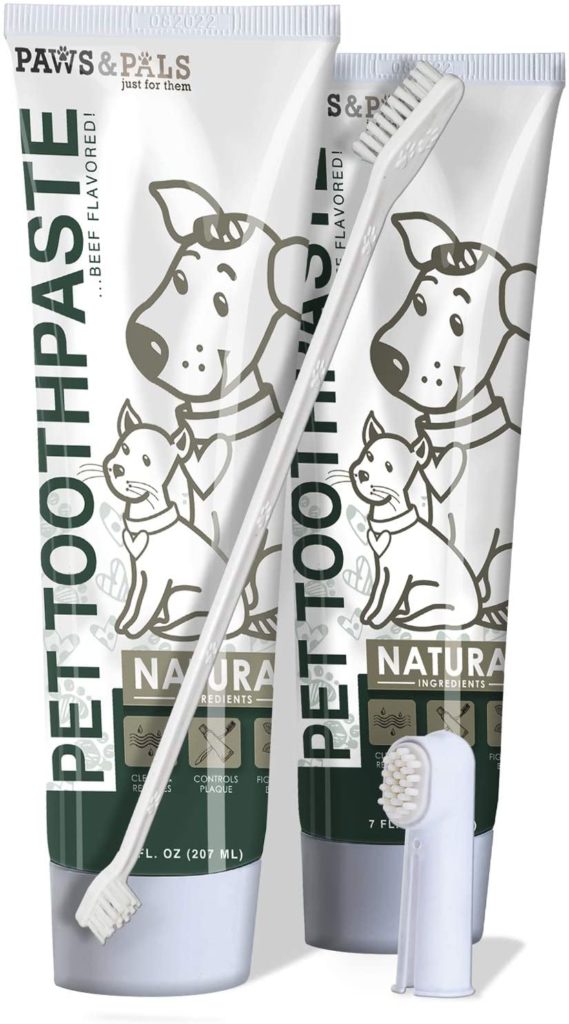
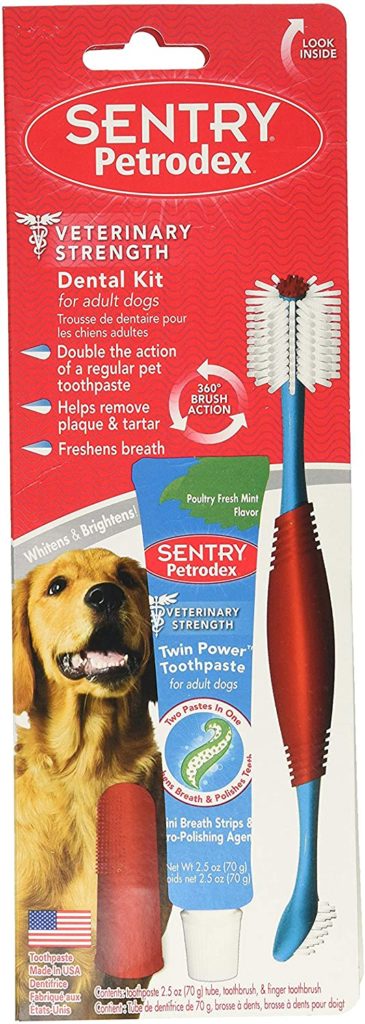
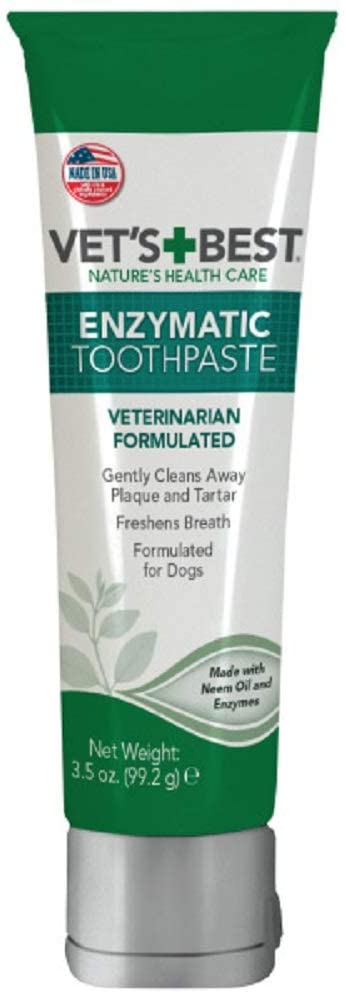
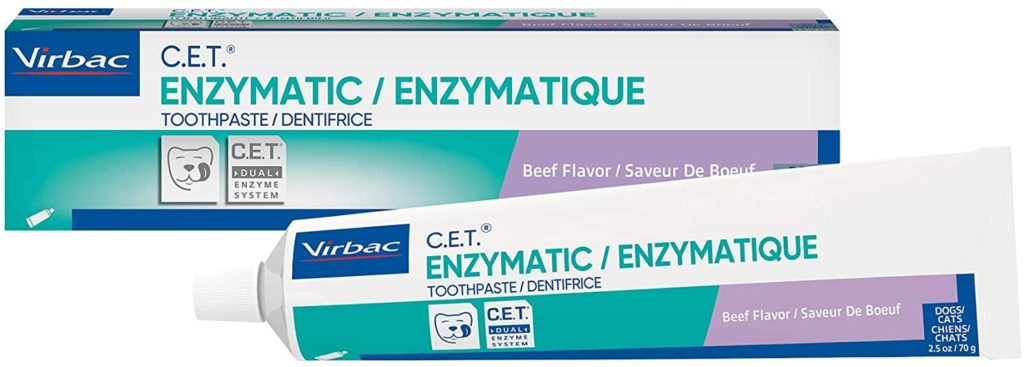
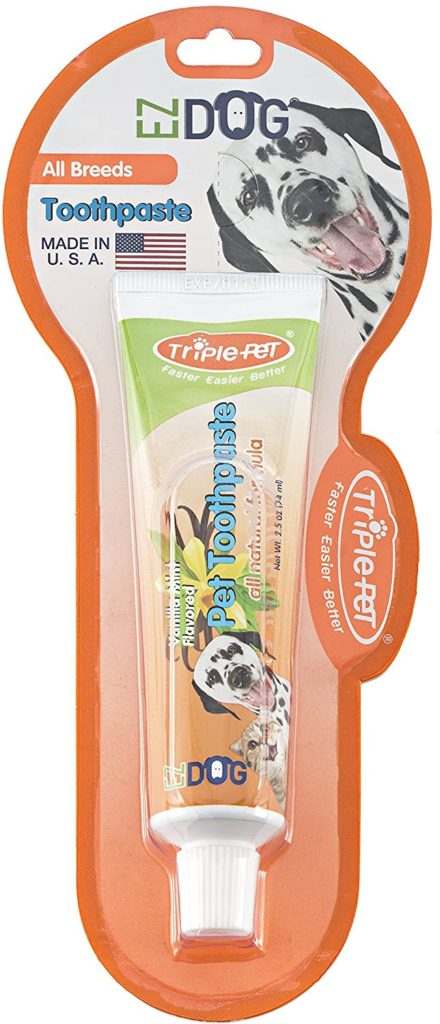
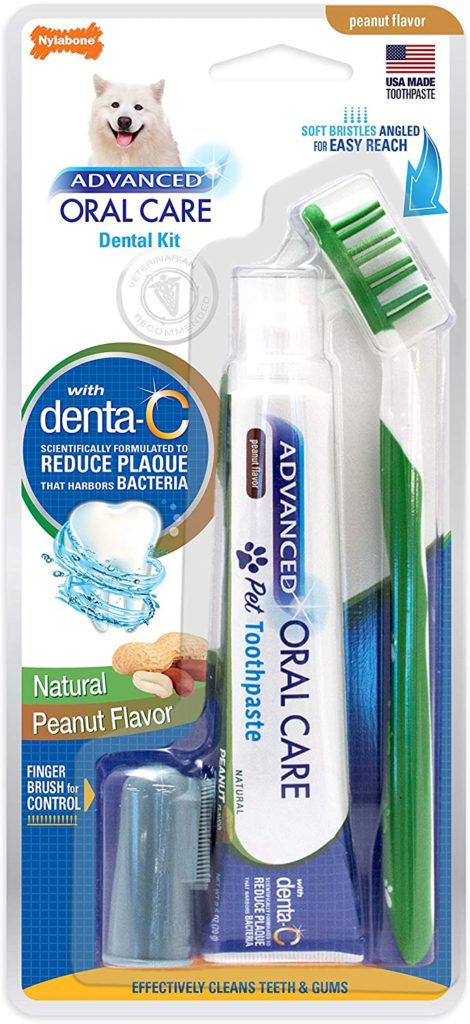
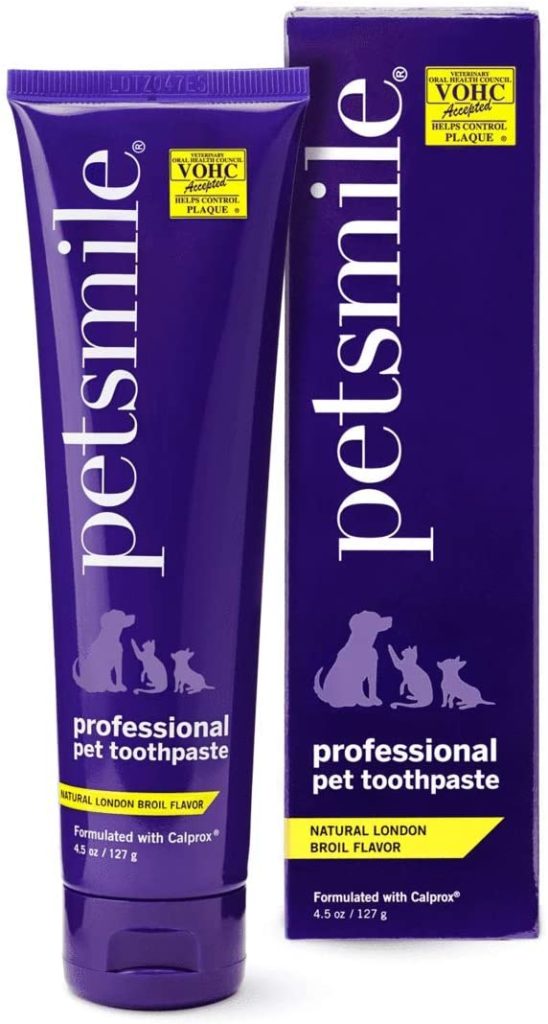
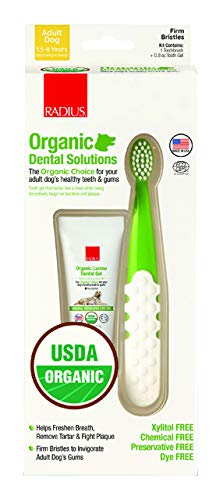
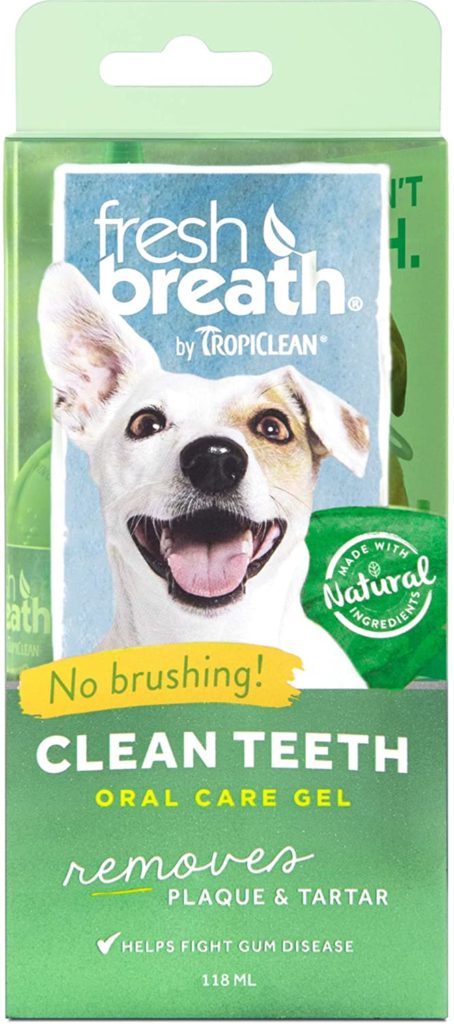




No comment yet, add your voice below!